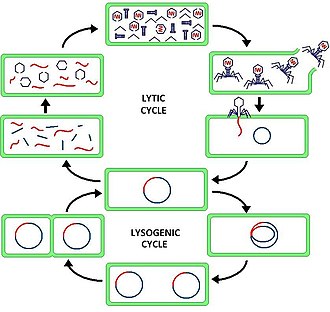Lytic cycle
Overview of the lytic cycle in bacteriophages
Lytic Cycle[edit]
The lytic cycle is one of the two main life cycles of bacteriophages, the other being the lysogenic cycle. In the lytic cycle, the phage replicates within a bacterium, ultimately leading to the lysis, or destruction, of the host cell and the release of new phage particles.

Attachment[edit]
The lytic cycle begins with the attachment of the phage to the surface of the bacterial cell. This is a highly specific interaction, where the phage recognizes and binds to specific receptors on the bacterial surface.
Penetration[edit]
After attachment, the phage injects its genetic material into the host cell. The phage's capsid remains outside the bacterium, while the DNA or RNA enters the host.
Biosynthesis[edit]
Once inside, the phage DNA takes over the host's cellular machinery to synthesize phage components. The host's ribosomes, enzymes, and nucleotides are used to produce phage proteins and replicate the phage genome.
Maturation[edit]
During maturation, the newly synthesized phage components are assembled into complete phage particles. This includes the assembly of the phage head, tail, and tail fibers.
Lysis[edit]
The final stage of the lytic cycle is the lysis of the host cell. The phage produces lysozyme or other enzymes that degrade the bacterial cell wall, causing the cell to burst and release the newly formed phages into the environment.
Significance[edit]
The lytic cycle is significant in the context of bacterial infections and phage therapy. It is a mechanism by which phages can control bacterial populations and has potential applications in treating antibiotic-resistant bacterial infections.
Related Pages[edit]
Ad. Transform your life with W8MD's Budget GLP-1 injections from $75


W8MD offers a medical weight loss program to lose weight in Philadelphia. Our physician-supervised medical weight loss provides:
- Weight loss injections in NYC (generic and brand names):
- Zepbound / Mounjaro, Wegovy / Ozempic, Saxenda
- Most insurances accepted or discounted self-pay rates. We will obtain insurance prior authorizations if needed.
- Generic GLP1 weight loss injections from $75 for the starting dose.
- Also offer prescription weight loss medications including Phentermine, Qsymia, Diethylpropion, Contrave etc.
NYC weight loss doctor appointmentsNYC weight loss doctor appointments
Start your NYC weight loss journey today at our NYC medical weight loss and Philadelphia medical weight loss clinics.
- Call 718-946-5500 to lose weight in NYC or for medical weight loss in Philadelphia 215-676-2334.
- Tags:NYC medical weight loss, Philadelphia lose weight Zepbound NYC, Budget GLP1 weight loss injections, Wegovy Philadelphia, Wegovy NYC, Philadelphia medical weight loss, Brookly weight loss and Wegovy NYC
|
WikiMD's Wellness Encyclopedia |
| Let Food Be Thy Medicine Medicine Thy Food - Hippocrates |
Medical Disclaimer: WikiMD is not a substitute for professional medical advice. The information on WikiMD is provided as an information resource only, may be incorrect, outdated or misleading, and is not to be used or relied on for any diagnostic or treatment purposes. Please consult your health care provider before making any healthcare decisions or for guidance about a specific medical condition. WikiMD expressly disclaims responsibility, and shall have no liability, for any damages, loss, injury, or liability whatsoever suffered as a result of your reliance on the information contained in this site. By visiting this site you agree to the foregoing terms and conditions, which may from time to time be changed or supplemented by WikiMD. If you do not agree to the foregoing terms and conditions, you should not enter or use this site. See full disclaimer.
Credits:Most images are courtesy of Wikimedia commons, and templates, categories Wikipedia, licensed under CC BY SA or similar.
Translate this page: - East Asian
中文,
日本,
한국어,
South Asian
हिन्दी,
தமிழ்,
తెలుగు,
Urdu,
ಕನ್ನಡ,
Southeast Asian
Indonesian,
Vietnamese,
Thai,
မြန်မာဘာသာ,
বাংলা
European
español,
Deutsch,
français,
Greek,
português do Brasil,
polski,
română,
русский,
Nederlands,
norsk,
svenska,
suomi,
Italian
Middle Eastern & African
عربى,
Turkish,
Persian,
Hebrew,
Afrikaans,
isiZulu,
Kiswahili,
Other
Bulgarian,
Hungarian,
Czech,
Swedish,
മലയാളം,
मराठी,
ਪੰਜਾਬੀ,
ગુજરાતી,
Portuguese,
Ukrainian